#African Grey behavior
Link
#The Secret Life of African Grey Parrots#What You Need to Know Before Owning African Grey#TiktokParrot#African Grey#African Grey behavior#African Grey Care#african grey care guide#African grey lifespan#african grey lifespan captivity#African Grey Parrot#African Grey Parrot Care#african grey parrot lifespan#African Grey Parrots#care for african grey parrot#care of african grey parrot#Diet of African grey#Grey Parrots#life expectancy of african grey parrot#life expectancy of an african grey parrot#Life of African Grey Parrot#Life of African Grey Parrots#life span of african grey parrots#life span of an african grey#lifespan african grey#lifespan african grey parrot#lifespan of african grey parrot#Secret Life of African Grey Parrots#The Secret Life of African Grey#Life of African Grey
5 notes
·
View notes
Text
I would like to offer this resource for therians, an extensive list of all of Sir David Attenborough’s nature documentaries that are available on soap2day, and a full list of what species* they each (notably, prominently) feature the natural behaviors of, separated by episode, and omitting species that were only shown dead, juvenile or being predated on. This took me a while (I have been working on it since Prehistoric Planet’s release) because I did in fact have to watch every single series in full in order to list all the species and the episodes are around 50 minutes long, but enjoy.
Long post ahead:
Most of these shows have closed captioning, which is why I’ve picked soap2day. Planet Earth is the only one that doesn’t. I did not include Dynasties and Dynasties II because each episode only features one species.
Thank you to Birch (@ambiguousmutt) for his help (he watched about half of the episodes) so I didn’t have to do it individually. Credit goes to him as well.
*Sometimes Attenborough doesn’t say the specific species and I was too busy trying to get through the episodes to identify it. In those cases I just put the most specific name I could.
Planet Earth
Episode one (From Pole to Pole): emperor penguin, polar bear, caribou, arctic grey wolf, Amur leopard, six-plumed bird-of-paradise, superb bird-of-paradise, great white shark, African elephant, African buffalo, lechwe, baboon, African wild dog
Episode two (Mountains): gelada, walia ibex, Ethiopian wolf, guanaco, cougar, grizzly bear, markhor, snow leopard, golden eagle, grey wolf, panda, golden snub-nosed monkey, red panda, demoiselle crane
Episode three (Fresh Water): giant salamander, grizzly bear, smooth-coated otter, Nile crocodile, dolphin fish, midge, Amazon river dolphin, dorado, piranha, spectacled caiman, crab-eating macaque, snow goose
Episode four (Caves): wrinkle-lipped free-tailed bat, cockroach, bat hawk, cave swiftlet, yellow-red rat snake, Texas blind salamander
Episode five (Deserts): Bactrian camel, dromedary camel, red kangaroo, fennec fox, guanaco, long-nosed bat, Nubian ibex, flat lizard, lion, African elephant, locust
Episode six (Ice Worlds): snow petrel, Antarctic petrel, south polar skua, humpback whale, emperor penguin, eider, muskox, arctic grey wolf, polar bear, little auk, arctic fox
Episode seven (Great Plains): Mongolian gazelle, red-billed quelea, wildebeest, snow goose, arctic fox, arctic grey wolf, bison, wild ass, Tibetan fox, pygmy hog, African elephant, lion, baboon
Episode eight (Jungles): magnificent bird-of-paradise, spider monkey, howler monkey, siamang gibbon, gliding tree frog, colugo, red crab spider, African elephant, chimpanzee
Episode nine (The Shallow Seas): humpback whale, multiple corals, banded sea krait, trevally, dugong, bottlenose dolphin, Socotra cormorant, salp, comb jelly, sea lion, dusky dolphin, sea urchin, sunflower starfish, short-tailed stingray, great white shark, king penguin, fur seal
Episode ten (Seasonal Forests): Eurasian lynx, moose, crossbill, wolverine, western capercaillie, pine marten, great grey owl, pudu, kodkod, mandarin duck, cicada, red deer, Amur leopard, tiger, mouse lemur
Episode eleven (Ocean Deep): whale shark, oceanic whitetip shark, common dolphin, Cory's shearwater, manta ray, sea spider, vampire squid, spider crab, unnamed deep sea eel, giant isopod, chambered nautilus, Pacific spotted dolphin, mola mola, frigatebird, sailfish, blue whale
Planet Earth II
Episode one (Islands): pygmy three-toed sloth, Komodo dragon, sifaka, marine iguana, Galapagos racer, Buller's albatross, fairy tern, Christmas Island red crab, yellow crazy ant, chinstrap penguin
Episode two (Mountains): Nubian ibex, red fox, golden eagle, grizzly bear, bobcat, flamingo, mountain viscacha rat, snow leopard
Episode three (Jungles): spider monkey, flying lizard, sword-billed hummingbird, river dolphin, jaguar, glass frog, paper wasp, click beetle, red bird of paradise, Wilson's bird of paradise, indri
Episode four (Deserts): lion, Harris's hawk, shrike, locust, sand grouse, pale chanting goshawk, feral mustang, golden mole, desert long-eared bat, darkling beetle, Namaqua chameleon
Episode five (Grasslands): saiga antelope, lion, harvest mouse, carmine bee-eater, Kori bustard, African elephant, serval, Jackson's widowbird, grasscutter ant, compass termite, giant anteater, bison, red fox, arctic grey wolf
Episode six (Cities): langur, peregrine falcon, leopard, European starling, great bowerbird, raccoon, rhesus macaque, spotted hyena, wels catfish
Our Planet
Episode one (One Planet): lesser flamingo, orchid bee, golden-collared manakin, red-capped manakin, blue manakin, cormorant, booby, common dolphin, shearwater, African wild dog, timber wolf
Episode two (Frozen Worlds): gentoo penguin, wandering albatross, narwhal, Pacific walrus, humpback whale, orca, leopard seal, polar bear
Episode three (Jungles): lowland gorilla, forest elephant, black sicklebill, twelve-wired bird-of-paradise, western parotia, mountain treeshrew, Philippine eagle, black spider monkey, leafcutter ant, Sumatra orangutan, velvet worm
Episode four (Coastal Seas): northern fur seal, compass jellyfish, giant trevally, mobula ray, Atlantic stingray, bottlenose dolphin, grey reef shark, whitetip reef shark, sea otter, California sheephead wrasse, Steller's sea lion, bald eagle, humpback whale, Guanay cormorant, Inca tern, Peruvian booby, South American sea lion
Episode five (From Deserts to Grasslands): Socotran cormorant, Arabian leopard, Arabian oryx, African elephant, cheetah, bison, Alcon blue butterfly, saiga, Przewalski's wild horse, tiger
Episode six (The High Seas): blue whale, spinner dolphin, mobula ray, oarfish, anglerfish, bristle worm, giant petrel, black-browed albatross, wandering albatross, bluefin tuna, sea lion, humpback whale
Episode seven (Fresh Water): Australian pelican, torrent duck, grizzly bear, manatee, giant mayfly, common kingfisher, osprey, jaguar, callipterus cichlid, Siamese fighting fish, hippopotamus, lion, African elephant, sandhill crane
Episode eight (Forests): Siberian tiger, bald eagle, rough-skinned newt, great hornbill, African elephant, African wild dog, fossa, gray mouse lemur
A Perfect Planet
Episode one (Volcano): lesser flamingo, marabou stork, Galápagos land iguana, vampire ground finch, Aldabra giant tortoise, North American river otter, coyote, Kamchatka brown bear, wildebeest
Episode two (The Sun): yellow-cheeked gibbon, fig wasp, arctic grey wolf, wood frog, garter snake, arctic fox, Saharan silver ant, golden snub-nosed monkey, sooty shearwater, humpback whales
Episode three (Weather): straw-colored fruit bat, fire ant, Amazonian giant river turtle, desert rain frog, Bactrian camel, Christmas Island red crab, carmine bee-eater, Nile crocodile, African fish eagle, hippopotamus
Episode four (Oceans): common dolphin, marine iguana, flightless cormorant, flamboyant cuttlefish, eider, bottlenose dolphin, lemon shark, manta ray, blacktip reef shark, trevally, rockhopper pengin, Eden's whale
Episode five (Humans): none
Life
Episode one (Challenges of Life): bottlenose dolphins, cheetah, panther chameleon, orca, brown-tufted capuchin, stalk-eyed fly, hippopotamus, Clark's grebe, giant Pacific octopus, strawberry poison-dart frog, leopard seal, orangutan
Episode two (Reptiles and Amphibians): pebble toad, caiman, basilisk, Brazilian pygmy gecko, panther chameleon, Namaqua chameleon, red-sided garter snake, collared iguana, hog-nosed snake, horned lizard, sea krait, African bullfrog, Komodo dragon
Episode three (Mammals): Weddell seal, elephant shrew, aye-aye, caribou, straw-colored fruit bat, lion, spotted hyena, polar bear, brown-nosed coati, meerkat, African elephant, humpback whale
Episode four (Fish): sailfish, flying fish, weedy sea dragon, convict fish, sarcastic fringehead, mudskipper, Hawaiian freshwater goby, hippopotamus, barbel, silvertip shark, clownfish, sea lion, ragged tooth shark, multiple snapper, whale shark
Episode five (Birds): spatuletail hummingbird, lammergeier, red-billed tropicbird, magnificent frigatebird, red knot, horseshoe crab, lesser flamingo, chinstrap penguin, great white pelican, Clark’s grebe, sage grouse, Vogelkop bowerbird
Episode six (Insects): Darwin’s beetle, unnamed damselfly, monarch butterfly, alkali fly, Wilson’s phalarope, oogpister beetle, mongoose, bombardier beetle, honey bee, black bear, Japanese red bug, Dawson’s bee, grass cutter ant
Episode seven (Hunters and Hunted): ibex, short-tailed stoat, brown bear, Ethiopian wolf, California ground squirrel, star-nosed mole, cheetah, red fox, greater bulldog bat, bottlenose dolphin, Bengal tiger, rattlesnake, orca
Episode eight (Creatures of the Deep): Pompeii worm, Humboldt squid, nemertean worm, moon jelly, fried egg jellyfish, spider crab, stingray, cuttlefish, giant Pacific octopus, sunflower sea star, king crab, cleaner shrimp
Episode nine (Plants): monarch butterfly, purple-throated carib hummingbird
Episode ten (Primates): Hamadryas baboon, Japanese macaque, lowland gorilla, spectral tarsier, phayre's leaf monkey, ring-tailed lemur, Sumatra orangutan, chacma baboon, white-faced capuchin, brown-tufted capuchin, western chimpanzee
Blue Planet II
Episode one (One Ocean): bottlenose dolphin, tuskfish, tern, giant trevally, mobula ray, false killer whale, Asian sheepshead wrasse, orca, humpback whale, walrus
Episode two (The Deep): sea toad, Venus’ flower basket, unnamed shrimp, ethereal snailfish, cock-eyed squid, pyrosome, barrel-eyed fish, unnamed siphonophore, yeti crab, Humboldt squid, fangtooth fish, sixgill shark, scabbardfish, zombie worm
Episode three (Coral Reefs): broadclub cuttlefish, coral grouper, day octopus, multiple corals, green turtle, bottlenose dolphin, manta ray, bobbit worm, saddleback clownfish, marbled grouper, grey reef shark
Episode four (Big Blue): spinner dolphin, yellowfin tuna, mobula ray, sailfish, sperm whale, sea turtle, blue shark, great white shark, multiple jellyfish, Portuguese man o' war, whale shark, wandering albatross, shortfin pilot whale
Episode five (Green Seas): Garibaldi, Australian giant cuttlefish, weedy seadragon, common octopus, pyjama shark, sea otter, tiger shark, smooth stingray, zebra mantis shrimp, common dolphin, humpback whale
Episode six (Coasts): Pacific leaping blenny, king penguin, southern elephant seal, Sally Lightfoot crab, Galápagos sea lion, ochre starfish, clingfish, chain moray eel, Atlantic puffin, arctic skua
Episode seven (Our Blue Planet): none
Prehistoric Planet
Episode one (Coasts): Tyrannosaurus rex, Tethydraco, Phosphatodraco, Tuarangisaurus, Mosasaurus hoffmannii, pycnodont fish, ammonites, Kaikaifilu
Episode two (Deserts): Dreadnoughtus, Tarbosaurus, Velociraptor, Mononykus, Barbaridactylus, Secernosaurus
Episode three (Freshwater): Velociraptor, Tyrannosaurus rex, Deinocheirus, Quetzalcoatlus, Masiakasaurus, Beelzebufo, elasmosaur
Episode four (Ice Worlds): dromaeosaur, hadrosaur, Ornithomimus, Olorotitan, troodontid, Antarctopelta, Pachyrhinosaurus, Nanuqsaurus
Episode five (Forests): Austroposeidon, Triceratops, Carnotaurus, Qianzhousaurus, Edmontosaurus, Atrociraptor, Anodontosaurus, Therizinosaurus, Telmatosaurus, Hatzegopteryx
The Hunt
Episode one (The Hardest Challenge): African leopard, African wild dog, Parson’s chameleon, nose-horned chameleon, African mantis, Darwin’s bark spider, Nile crocodile, Amur falcon, orca, cheetah
Episode two (Arctic): polar bear, arctic grey wolf, arctic fox, glaucous gull
Episode three (Forests): tiger, American marten, sparrow hawk, Portia spider, tarsier, harpy eagle, chimpanzee, army ant
Episode four (Oceans): blue whale, frigatebird, dorado, sargassum fish, spinner dolphin, Beroe ovata, Chiroteuthis, lionfish, black-browed albatross, sea lion, tuna, copper shark, common dolphin, Bryde's whale
Episode five (Plains): cheetah, caracal, honey badger, termite, bald eagle, lion, Ethiopian wolf, hotrod ant, spoor spider
Episode six (Coasts): bottlenose dolphin, algae octopus, sand bubbler crab, long-tailed macaque, marine otter, grizzly bear, grey wolf, peregrine falcon, orca, humpback whale
Episode seven (Conservation): none
Life In Colour
Episode one (Seeing In Color): Indian peafowl, mandrill, Costa’s hummingbird, magnificent bird-of-paradise, blue moon butterfly, fiddler crab, mantis shrimp, flamingo, poison dart frog
Episode two (Hiding In Color): Bengal tiger, langur, ptarmigan, crab spider, zebra, Cuban painted snail, blue-striped fangblenny, common waxbill, pin-tailed wydah, Augrabies flat lizard
Frozen Planet II
Episode one (Frozen Worlds): emperor penguin, orca, Pallas’s cat, Siberian tiger, grizzly bear, hooded seal, polar bear
Episode two (Frozen Ocean): polar bear, beluga, harp seal, skeleton shrimp, crested auklet, orca
Episode three (Frozen Peaks): high-casqued chameleon, japanese macaque, kea, andean flamingo, giant panda, golden eagle, andean mountain lion
Episode four (Frozen South): king penguin, Antipodean wandering albatross, blue whale, Weddell seal, chinstrap penguin, snow petrel, leopard seal, orca
Episode five (Frozen Lands): grey wolf, arctic fox, Amur leopard, Siberian tiger, painted turtl, Lapland bumblebee, snowy owl, caribou, grizzly bear
Episode six (Our Frozen Planet): none
Africa
Episode one (Kalahari): fork-tailed drongo, ostrich, black rhinoceros, Angolan giraffe, African leopard, armored ground cricket, spider wasp
Episode two (Savannah): Agama lizard, shoebill, bee-eaters and rollers, lesser flamingo, African elephant, crowned eagle, African fish eagle, martial eagle
Episode three (Congo): chimpanzee, central African rock python, Angola banana frog, African skimmer, rockfowl, African elephant
Episode four (Cape): emperor swallowtail, giant kingfish, African penguin, monkey beetle, springbok, yellow-billed kite, pied crow, ghost crab, vundu catfish, Nile crocodile, Bryde’s whale, great white shark, common dolphin
Episode five (Sahara): Grevy’s zebra, naked mole rat, barn swallow, Dromedary camel, dung beetle, crocodile, western yellow wagtail, Saharan silver ant
Episode six (The Future): none
528 notes
·
View notes
Text
Rhysand stans

Lmao I just had an argument about Rhysand with a feysand stan in the comments and it's insane the length some of you guys will go to defend the biggest asshole in this entire series. It's honestly really sad to me because it shows that a lot of you guys don't understand how sexual assault, abuse, manipulation, and power deficits work. The truth is Feyre never truly understood what was done to her because she was constantly manipulated and beaten into being Rhysand's perfect little chick. Also clearly some of you guys didn't pay attention in history class, because the Night Court is exactly what segregation is. Sarah J Maas is implying it's ok. I'm pretty sure the African Americans who fought for years to end segregation would not appreciate this sentiment. SJM is feeding impressible teens dangerous themes that such behavior is okay, and I genuinely feel sorry for people who believe Feyre was in the right capacity to "forgive" Rhysand when her sexual assault was only ever truly acknowledged by her best friend, Lucien. That doesn't even get to the manipulation of when Feyre was at the Night Court. I call it the "illusion of choice," when information is withheld from you, as well as a severe power deficit, and Feyre clearly not being in the right mind after everything she went through at the Spring Court. It's also hilarious how some of you guys will call Tamlin abusive for locking Feyre in a house to protect her but will defend Rhysand to the death when he also locked Nesta in a house to "help" her. Haven't even mentioned the numerous problems with the pregnancy trope. There's nothing wrong with liking a morally grey character but this is the furthest thing from morally grey and we should stop listening to people who tell us this shit is sexy.
#anti inner circle#anti feysand#anti rhysand#pro lucien vanserra#pro nesta archeron#anti sjm#sjm critical
77 notes
·
View notes
Text
The DroughtofApathy Theatre Awards Nominations:

Best Ensemble
Stereophonic
Jaja's African Hair Braiding
Merrily We Roll Along
Illinoise
Best New Song
"Evanesce," Days of Wine and Roses (Adam Guettel)
"Masquerade," Stereophonic (Will Butler)
"East of Eden," Stereophonic (Will Butler)
Bad Accent
Eddie Redmayne's Muppet Voice
Whatever the fuck Jeremy Jordan was doing
Colton Ryan's Muppet Voice from last season, I'm still not over it
Diva Performance of the Year
Jennifer Simard, Once Upon a One More Time
Jessica Lange, Mother Play
Emily Skinner, Suffs
Most Incredible Scene Transition
The I Need That home cleanup transition
Opening up Jaja's African Hair Braiding shop
Mary Jane's apartment set lifting up to reveal the hospital set
Doubt revolving set
Appropriate house falling into shambles with a tree and everything
De-renovating the Broadway Theatre after Here Lies Love flopped
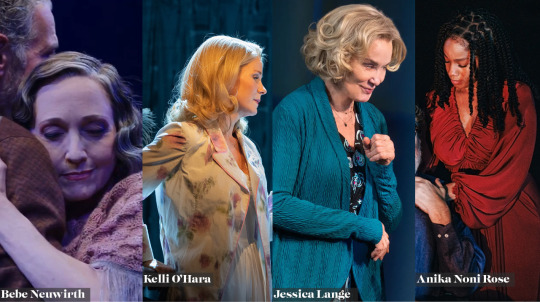
Most Beautiful Woman On Stage
Bebe Neuwirth, Cabaret
Kelli O'Hara, Days of Wine and Roses (bonus points for The Hours)
Jessica Lange, Mother Play
Anika Noni Rose, Uncle Vanya
Moment So Horrifyingly Bad I Physically Recoiled
Eddie Redmayne as the Emcee singing "Tomorrow Belongs to Me" BEFORE the party
Everything Gayle Rankin did on that stage
"My name is Ponyboy//I'm the youngest of the three," lyric from The Outsiders
The Hell's Kitchen book being allowed on Broadway at all
Most Hated Sound Designer
Gareth Owen, The Who's Tommy
Jon Weston, The Wiz
Gareth Owen, Hell's Kitchen (hey, a doubly-bad showing)
Brian Ronan, The Great Gatsby, but specifically those gunshots

Floppiest Flop Show
How to Dance in Ohio
Lempicka
Here Lies Love
Grey House
Once Upon a One More Time
Weirdest Marketing/Publicity/Social/Design Decision
How to Dance in Ohio only emphasizing "AUTISM REP" over everything that might have drawn in any kind of crowd at all.
The Lempicka social media team just straight-up lying with their pull-quotes and then doubling down and getting snide.
Broadway producer Greg Nobile's twitter discourse.
The Cabaret social media brand refusing to acknowledge Bebe Neuwirth exists and is the only thing holding that show together.
Who did the Days of Wine and Roses cast album design and like...why?
Can You Spell Miscast?
Eddie Redmayne, Cabaret
Gayle Rankin, Cabaret
Eden Espinosa, Lempicka
Basically all of The Wiz
Doubly so for The Great Gatsby
Star-in-the-Making
Sarah Pidgeon, Stereophonic
The Grey House kids
Hannah Cruz, Suffs
Amber Iman, Lempicka
Anna Zavelson, Encores! The Light in the Piazza (not Broadway, but I said what I said)
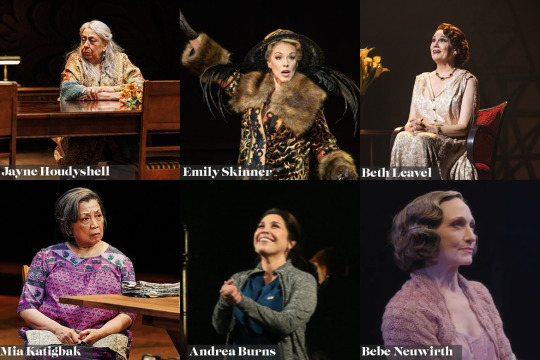
Criminally Underutilized Older Character Actress
Jayne Houdyshell, Uncle Vanya
Emily Skinner, Suffs
Andrea Burns, The Notebook
Beth Leavel, Lempicka
Mia Katigbak, Uncle Vanya
Bebe Neuwirth, Cabaret
Worst Audience Behavior
The couple who stayed on their phones the whole time at The Wiz.
The guy who started screaming and fighting at the top of act two at Hell's Kitchen.
The drunk women at Melissa Etheridge who were singing and flailing the whole show.
Shrieking girls at Bad Gatsby whenever the leading man did anything.
Family in front of me at Heart of Rock and Roll.
Guy behind me at Cabaret crunching wine chips through all of act two.
Iconic Merch Item
Rosie the Elephant, Water for Elephants: she's so soft and well-made and perfect and I love her and need her.
Great American Bitch clothing, Suffs
Mother Hat, Mother Play
Tissue box, The Notebook
Moment that Had Me in Tears
When *spoiler* off-stage, Jaja is taken in by ICE and her daughter can't find her and may face deportation herself.
Merrily We Roll Along overture.
Mary Jane breakdown over the music therapist.
All of Maryann Plunkett's masterful performance in The Notebook.
Me going home to sob over how they butchered Cabaret.
Kimberly Akimbo final performance, it might've opened last season, but fight me
Reading an article on the opening of the Bad Gatsby where a car hit a pedestrian right next to where all the celebrities were getting their photos taken and no one noticed. (tears of laughter-pedestrian was not hurt badly)
Single Best Costume
Emily Skinner's Dorothy Louden coat
Jennifer Simard, titties up and out as the Stepmother
Sara Gettlefinger's fun jumpsuit and headscarf combo
Anika Noni Rose entrance blue gown with the plunging neckline and deep v back
Bebe Neuwirth's little pink nightie and phenomenal shawl
Kate Baldwin's off-the-shoulder outfits in the regional production of A Little Night Music

Best Playbill Design
Stereophonic - 10/10 no notes
Suffs - Like the art style
Illinoise - I really like the colors and art style
Here Lies Love - I like the colors

Worst Playbill Design
Cabaret - you should be ashamed of yourself. Not even the title
Doubt - I know there was a last-minute replacement, but c'mon
Lempicka - whoever did this should be taken out back and shot
Spamalot - it's just the same damn design as the original, but brighter and worse
Tony Snub
Laurie Metcalf, Grey House
Jennifer Simard, Once Upon a One More Time
Chip Zien, Harmony
Days of Wine and Roses, Best Musical
Grey House, Best Scenic Design of a Play
Cars on Broadway
The Bad Gatsby cars that actually drive
The Lempicka silver car that isn't green and doesn't drive
The Illinoise concept car made out of props and actor's bodies
The Back to the Future car that files and spins and shit
#broadway#theatre#welcome to the theatre: diary of a broadway baby#we're having fun over here at DOA headquarters
10 notes
·
View notes
Text
CW EDs: IT’S NOT ALWAYS PICA.
Okay super niche rant but this pisses me off so much.
I am very tired of seeing some know-it-all in the comments of social media videos where a Black person happens to be eating clay/chalk/cornstarch saying “this is actually an eating disorder called Pica”
WRONG
Pica is when people eat indigestible non-food items. Think paper, erasers, tape, hair.
However, clay/chalk/cornstarch are known sources of minerals like calcium, zinc etc and there is a long history of Africans specifically seeking these things out for said nutrients- especially pregnant women.
This is a dietary need. Dietary needs aren’t Pica.
There‘s literally a purchaseable supplement for this specific thing.

(Pictured, a screenshot of a quick google search for ‘buy eating clay’ that shows several store results advertising edible clays or clays for eating, often suggested to be bentonite. The photos with the results show chunks of pale grey or other hued clays, either close up or packaged in plastic pouches for sale)
Therefore what I’ll call ‘clay craving’ isn’t fucking Pica. It’s a historically and culturally supported natural instinctive mineral craving and due to the historical prevalence and acceptance the cultural history allows it to have, this specific behavior is more often seen in African descendants.
Tell your friends. I’m tired of seeing this rude, ignorant, uneducated, anti-black, anti-indigenous comment on random harmless videos. It is also so fucked up to armchair diagnose someone with a fucking ED.
If you see someone eating clay, cornstarch, chalk ete online first off assume they know what the fuck they’re doing and just watch the video.
--Some context, bc for many of you this will seem off the wall--
I just saw a video of a Black girl eating chunks of white stuff and recording the sound which was squeaky and powdery. It seemed like it could have been powdered sugar but didn’t dissolve fast enough for that to make sense, so I checked the comments which is where I found someone simultaneously saying it was cornstarch and saying the OP had pica.
A few months ago a video was going around on insta/tok of a pregnant Black woman from Africa with the context from the (white) husband that she had told him she was craving clay and he, despite not really understanding such an odd thing, would do anything to get it for her. In the end he does, and she is shown happily eating patties of clay on a plate. People in the comments were all talking about how it was wrong / weird / unhealthy and how it was Pica.
**** Google shit before you make dumb comments pls***
123 notes
·
View notes
Text
daemon roundup: wolves
i've been wanting to do a write-up on wolf daemon forms for a while now as i think they're a popular form and the phylogenetic distinction between the grey wolf and all of its subtypes is fascinating. species outside of the grey wolf are often considered nonviable due to their overlap with the grey wolf but also the difficulty researching their ecology. so here is going to be my deep dive on the wolf daemon persona overall, as well as what canis lupus subspecies (as well as peripheral species of the african wolf, eastern wolf, and red wolf) can be considered viable forms.
the wolf personality overall
subspecies aside, all wolf daemon individuals are going to share some essential traits.
— loyal and cooperative. canis lupus forms, both the wild wolf and domestic dog, are notorious for their sense of community and hierarchy. wolves depend on the group for survival; social dynamics among the pack are incredibly complex, reinforcing tight-knit bonds and a democratic hierarchy among the family unit. wolves play, console each other, and develop unique pack culture through intergenerational communication. while sociability and extroversion varies between subspecies, all people with wolf daemons are going to naturally form or desire close friendships, and they are committed and generous to the ones they love.
— communicative and tactful. similar to above, wolf individuals are very honest and expressive. wolves have very advanced communication that include vocalizations, body language, and scent marking. this enables them to diffuse conflict and reinforce hierarchy, maintaining stability in the pack. while inter-pack aggression isn't rare, territories are defined through olfactory signaling and vocalizations. those with wolf daemons therefore prioritize clearly expressing themselves and their boundaries. they are socially intuitive and value group harmony; it is important for them to know where they stand and that tension is diffused as quickly as possible.
— dutiful and hardworking. wolf individuals are driven and reliable, committed to pulling their weight and motivated in their work ethic. wolf species are clever and cooperative hunters, chasing down much larger prey until their target is exhausted, then latching on and dragging their prey down with incredible resiliency. those with wolf daemons don't shy away from hard work, though they are also perceptive enough to observe obstacles from all angles and determine how to work smarter not harder. once they have initiated something, they often become absorbed in it and are driven to see it through.
— self-assured and resourceful. those with wolf daemons tend to be confident — or at least assured that they will be able to overcome what troubles them. wolves are typically apex predators of their biomes. they are assertive in maintaining hierarchy and defending territories; while tactful, as mentioned above, the wolf individual takes pride in themselves and aren't often self-doubting, particularly when they have group support. they adapt when change or hardship comes to them and are the type of person who is good at putting their head down and making do.
for these reasons, wolf personalities are often categorized as xxFJs. they are strong Fe users and i believe an argument could be made for either Si or Ni. they are also likely relatable to enneagram 6s and 2s as well as potentially 7s and 8s. however personality assignment is fairly subjective, so if you feel this fits you, don't shy away considering these forms.
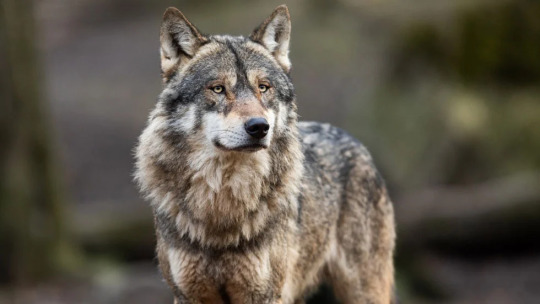
grey wolf, canis lupus
the grey wolf has already received an extensive TDF analysis, and overall serve as a general template to which to compare canis lupus subspecies. to point out several unique aspects of the grey wolf, it must be stated that the grey wolf tends to be one of the most social and group-oriented wolves. they have a strong focus on hierarchy and cooperation. they are also highly adaptable and even-tempered, capable of flexible behavior and adjusting strategies wherever they might end up. this makes them rather quietly bold and ambitious people; they are at ease out of their comfort zone, and they are dedicated to seeing their projects and intentions through. grey wolf daemians, in addition to the general wolf traits, are extroverted, confident, flexible, straightforward, and committed.
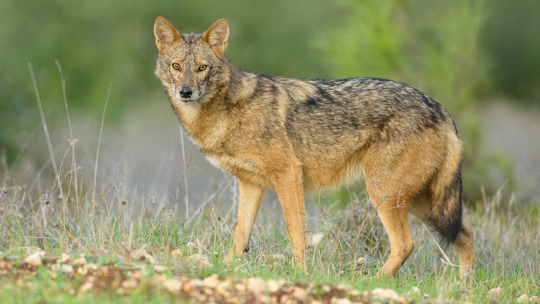
african wolf, canis lupaster
the african wolf, also called the golden wolf, is native to northern africa. it is a small wolf subspecies, intermediate between the jackal and the wolf, though its appearance changes based on its location: eastern african wolves tend to be small and more jackal-like, while northern and western african wolves tend to be larger and more wolf-like. despite this, they are genetic descendants of grey wolf and ethiopian wolf cross. african wolves live in small, flexible packs that fluctuate depending on prey availability. their social groups are demonstrative and affectionate; african wolves have frequently been observed grooming, playing, and courting. they are extraordinarily territorial and can be highly aggressive to intruders though interestingly are primarily reactive to intruders of the same sex. altogether, this paints a picture of an individual who's competitive and extroverted, gravitating towards like-minded companions but individualistic enough to head out on their own. their hunting habits are, indeed, varied; african wolves do take large prey, but overall value a generalist diet, employing multiple strategies such as turning over dung piles to find beetles. they will hunt more than they can consume and cache the prey until later — though they are highly territorial and hostile towards other scavengers. african wolf daemians, in addition to the general wolf traits, are adaptable, assertive, individualistic, socially savvy, and inventive.
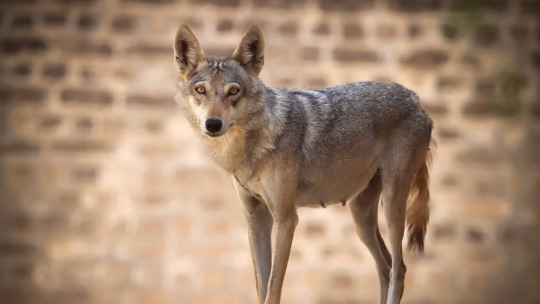
arabian wolf, canis lupus arabs
the arabian wolf is native to the arabian peninsula and lives in arid desert and mountain habitats. they are one of the smallest wolf subspecies, also notable for their large ears that help them disperse body heat. these wolves live in small groups and have an opportunistic, omnivorous diet. they tend to hunt alone or in small groups, though there is heavy competition for prey and they will readily rifle through human garbage. compared to grey wolves, arabian wolves are substantially less social. they only aggregate into larger groups during mating season or when prey is plentiful; otherwise, the arabian wolf is less territorial and not terribly communicative, and tends to be nomadic and always on the move. the arabian wolf soul is a perceptive survivalist, highly adaptable but prioritizes their flexibility to such a degree it makes them less likely to depend on others. they're more unobtrusive and self-focused, though they have the capability to be cooperative and are certainly tolerant of others. their competitive nature is essential to their form, however — it's a priority for them to have all of their needs accounted for, but their opportunism makes them highly resilient and they are excellent at completing projects even if it involves cutting corners. arabian wolf daemians, in addition to the general wolf traits, are going to be individualistic, self-motivated, flexible, not picky, and shrewd.

arctic wolf, canis lupus arctos
the arctic wolf is a grey wolf subspecies found in the high arctic tundra north of the treeline. these wolves are well-adapted for the snow and cold; they are a medium subspecies with small ears and possess a thick, typically white, double-layered coat. like the grey wolf, they live in packs and pursue large prey such as muskox and caribou. because their habitat is so isolated, they have very few natural predators (besides climate change) and tend to be rather confident and unafraid of people as a result. while arctic wolves are similar in sociability to the grey wolf, they are going to be overall more confident and specialized. these people are highly opportunistic and dogged when pursuing their goals, though they have a preference for depth over breadth. their ambition gives them resiliency and a self-assured nature. due to their tight ecosystem, these people will also be environmentally sensitive and perceptive — it is their preference that things are clear and they are in control, and they will endeavor to maintain stability in their relationships. these wolves also maintain extremely large territories often twice the size of grey wolf territories. an essential quality to this form is going to be how good they are at seeing the big picture, planning ahead, and ensuring their goals will be met. in addition to the general wolf traits, arctic wolf daemians are going to be specialized, confident, perceptive, resilient, and tenacious.

eastern wolf, canis lycaon
the eastern wolf is a subspecies found in eastern canada and is sometimes sub-divided into two subspecies: the great lakes wolf (larger, a higher percentage of grey wolf DNA) and the algonquin wolf (smaller, a higher percentage of coyote DNA). since they seem behaviorally similar, i'll be grouping them together. the eastern wolf is descended from a grey wolf/coyote hybrid similar to the red wolf; they are in between grey wolves and coyotes in size, and they live together in tight-knit packs. eastern wolves maintain rather small territories and primarily hunt deer, though their diet also consists of moose, elk, beavers, rodents, and berries. similar to grey wolves, they will often follow ungulate migrations and engage in food caching behavior. overall, the eastern wolf form is going to be fairly similar to the grey wolf. they are highly loyal and inventive, though a key distinction is that the eastern wolf is a degree more unobtrusive and conflict-avoidant than the grey wolf. they likely come across as more introverted and come to life around their loved ones. eastern wolves are also going to be somewhat more attached to routines and a sense of security, flexible when change is needed but not the type to take unnecessary risks. in addition to the general wolf traits, eastern wolf daemians are going to be dedicated, conflict-avoidant, supportive, cautious, and perceptive.
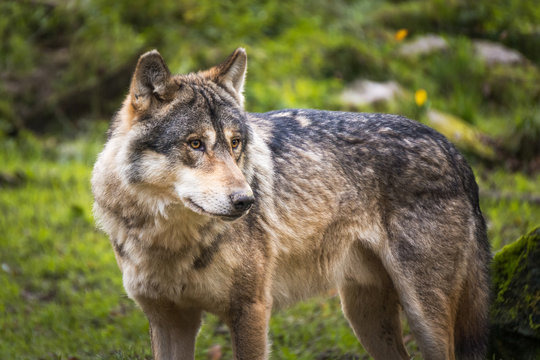
eurasian wolf, canis lupus lupus
the eurasian wolf, also called the common wolf, is native to europe and asia and can be distinguished from the grey wolf by their narrower snouts, shorter coats, and melodic howls. though the eurasian wolf has the largest range of all old world subspecies, they have lost a lot of their historical territory. their pack sizes tend to be smaller than grey wolves and they have an extremely varied diet — these wolves are often forced into populated areas and will subsist on livestock and human garbage. they tend to be less skittish around people than grey wolves as a result. similarly, they will often forage independently or in pairs as often as they will hunt in packs. their sociability is similar to grey wolves; eurasian wolf individuals will be similarly extroverted and tight-bonding, though can be distinguished by their survivalist and individualistic tendencies. they have a high degree of adaptability and can be inventive and risk-taking in their problem-solving. while loyal, they have confidence in themselves and their visions, willing to branch out in order to see things through. when compared to the grey wolf individual, the eurasian wolf soul can be distinguished by being more boldly adaptable, socially flexible, and ambitious, highly resilient to hardship. eurasian wolf daemians, in addition to the general wolf traits, are reliable, bold, adaptable, expressive, and quick-thinking.
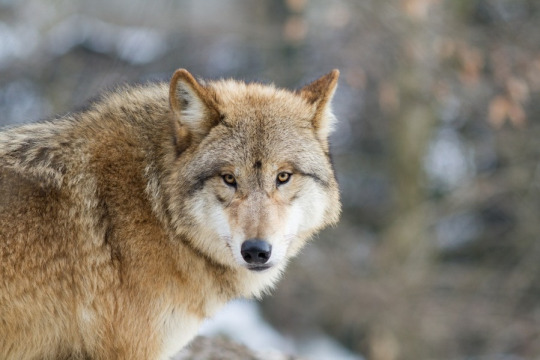
himalayan/tibetan wolf, canis lupus chanco
canis lupus chanco, called the himalayan wolf, tibetan wolf, and mongolian wolf, is found in the himalayas, tibetan plateau, and central asian highlands. this species is known for its thick and woolly coat which is typically fawn-colored to help it blend in among the steppes. they live in small packs and hunt both cooperatively and alone; prey include yaks, argali, kiang, antelope, and livestock. other notable aspects of the himalayan wolves is how they are biologically adapted for hypoxia and also have distinctly low and short howls. otherwise, this species closely resembles the grey wolf within its region. slight differences may exist in the himalayan wolf being more resilient and wary in nature, though overall they are still sociable and dependable individuals. likely due to their biome and their sparse distribution in the highlands, himalayan wolves also have a reputation of being less aggressive and territorial than grey wolves as well. these individuals are thus less assertive when their boundaries are crossed and would prefer to adapt their behavior or live and let live to avoid pointless conflict. in addition to the general wolf traits, himalayan wolf daemonians are going to be straightforward, perceptive, confident, tenacious, and tolerant.
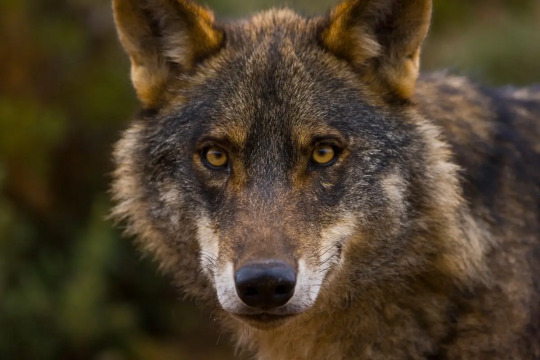
iberian wolf, canis lupus signatus
the iberian wolf is native to northwestern spain and portugal in relatively isolated populations that have resisted backcrossing or mixing with other wolf subspecies. these wolves are distinct for their slighter, small frame and the dark marks on their legs, upper lips, and tail (signatus for signed). it lives in small packs and its diet primarily consists of large ungulates such as deer, wild boar, and livestock, though like all wolves the iberian wolf is an opportunistic hunter and will also eat martens, feral cats, rabbits, and rodents. among its packs, the iberian wolf is hierarchical and a cooperative hunter; they have unique howls that are used for individual recognition and the dominant pair in the pack scent marks territory. while the iberian wolf is somewhat adaptable to their biome, they are reliant upon forest cover, and are known to be reclusive and rare even in their region. ultimately, this form embodies many aspects of the grey wolf in terms of expressiveness, group cohesion, and opportunism, but the iberian wolf will overall be more reserved and introverted. they are highly boundary-keeping and assertive — perhaps even wary at first, though natural problem-solvers who have a drive to succeed. their natural confidence makes them rather adamant and willing to take calculated risks similar to the grey wolf. iberian wolf daemians, in addition to the general wolf traits, are going to be introverted, opportunistic, perceptive, expressive, and protective.

indian wolf, canis lupus pallipes
the indian wolf is native to india as well as regions of southwest asia such as turkey and iran. overall indian wolves are small with short, thin fur and they live in open grasslands, thorn forests, and scrublands. while social, their packs are smaller than the grey wolf's, typically an average size of three and are widely dispersed across their habitat. interestingly, the indian wolf is a relatively less vocal species; they seem to rarely howl, though they have a wide repertoire of vocalizations including howling, "social squeaks", whimpers, and whines that they use to communicate with pack members. additionally, indian wolves tend to hunt small prey (such as rodents and rabbits) solitarily and larger prey (such as blackbuck and chinkara antelopes) in pairs, in which one indian wolf acts as a decoy. thus they've garnered a local reputation as extremely reclusive but clever animals — as is required, as the indian wolf has to compete with other local apex predators such as the tiger, dhole, and feral dog. the indian wolf individual is going to display some stark differences compared to the grey wolf, similar to other desert wolf subspecies. the first is that they're going to be much more individualistic, socially selective, and unobtrusive; indian wolves do not defend their territorials as strongly, and overall seem to prefer avoiding potential conflict. they're also going to be quick-thinking and highly cooperative, though even then somewhat reserved, perhaps slow to open up to others and wary about being the center of attention. in addition to the general wolf traits, indian wolf daemians are going to be introverted, observant, cunning, reserved, and conflict-avoidant.
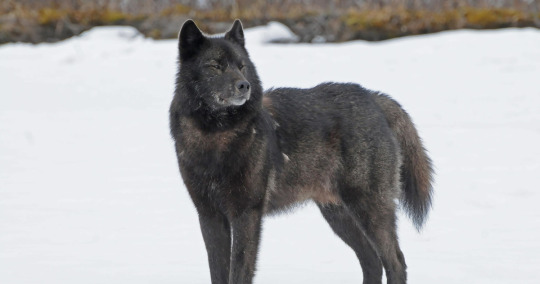
islands wolf, canis lupus ligoni
the islands wolf, commonly called the alexander archipelago wolf, is a subspecies found in a limited range in southeastern alaska along the coasts and islands. they are separated from the rest of north america by the coast mountains, creating a unique subpopulation that has resisted inbreeding with other wolf subspecies, coyotes, and dogs. the islands wolf is a small subspecies and is generally dark in color. they live in dense forests where they den in the roots of large trees and primarily hunt sitka deer, though will feed opportunistically on coastal species such as beaver, seals, salmon, birds, and marine invertebrates. their pack sizes can range between a pair or up to twelve members and the islands wolf is unique in that it does not disperse as much as other wolf subspecies and its home ranges are rather small. the islands wolf individual is thus going to show similar social tendencies as the grey wolf while being much more routine-oriented and less adaptable. this is one of the few wolf subspecies that is less opportunistic and highly dependent upon a single prey source; as such, the islands wolf soul tends to prioritize optimization and persistence when possible. they excel at exploiting opportunities though tend to be more sensitive when out of their comfort zone, as their preference is to stay with what is more dependable. it's also likely that they're socially flexible, comfortable in a variety of social situations and particularly cooperative and supportive when times become hard. islands wolf daemians, in addition to the general wolf traits, are dependable, routine-oriented, specialized, precise, and reserved.
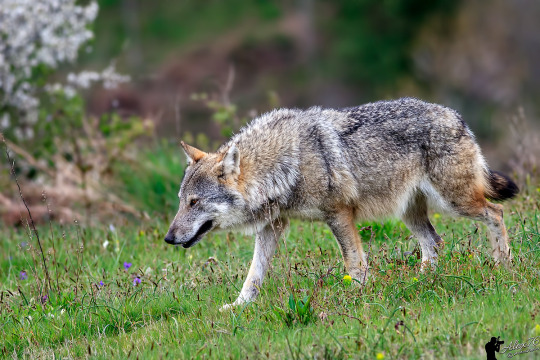
italian wolf, canis lupus italicus
the italian wolf is native to the mountain ranges of the italian peninsula, though it has modernly expanded northward into france and the french alps. these wolves are medium-sized and live in packs between two and seven members, though due to prey scarcity, they are most often found in packs consisting of a breeding pair and their adolescent offspring. they are opportunistic predators, feeding on medium-sized hoofed mammals like deer and boar, as well as smaller prey like rabbits, insects, and various fruits/berries. particularly in the summer, they are also voracious hunters of local livestock and will den near the edge of pastures on the mountain ridges. like most wolf subspecies, the italian wolf is also a cooperative hunter and highly social within its pack. similar to the grey wolf, they defend their territories and can be aggressive to intruders. overall, the italian wolf is going to be a similar form to the grey wolf particularly in terms of adaptability. they are confident, perceptive, and flexible, readily adapting or changing course when one avenue isn't working out. their sociability is somewhat more reserved than the grey wolf; they tend to be more private and protective, likely seen as reserved individuals who are tenacious when pursuing their goals or maintaining their boundaries. in addition to the general wolf traits, italian wolf daemonians are going to be dedicated, adaptable, tenacious, confident, and reserved.
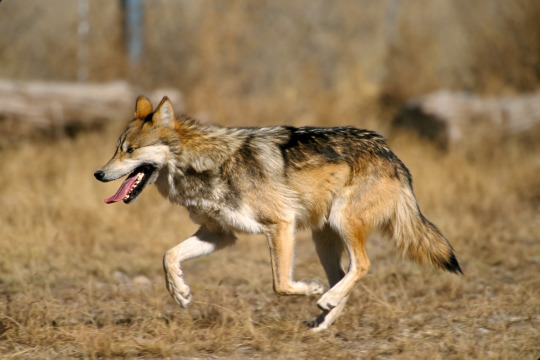
mexican wolf, canis lupus baileyi
the mexican wolf is a highly endangered subspecies endemic to northern mexico and the southwestern united states. the smallest north american wolf subspecies, the mexican wolf has long legs and a sleek physique. they live in mountain woodlands and deserts, maintaining large packs similar in size to grey wolves. their diet predominantly consists of elk, though they also will hunt deer, rabbits, and other small mammals, as well as scavenge carcasses and steal prey. these wolves are highly social and expressive; they have strong pack hierarchy and engage in play, vocalizations, and cooperative pup rearing. overall, the mexican wolf individual is going to be gregarious, supportive, and engaging. they are communicative and talkative, expressive and readily speaking their mind. like grey wolves, they're also going to be hierarchical and socially savvy, appreciating the dependability of a group and happy to cooperate to reach their aims. they're also somewhat individualistic like many wolf species, willing to hunt alone and will cache food away from the rest of the pack. despite their environmental sensitivity, mexican wolves are also going to be adaptable and inventive, similar to the grey wolf. mexican wolf daemians, in addition to the general wolf traits, are extroverted, vocal, flexible, energetic, and clever.

northern rocky mountain wolf, canis lupus irremotus
the northern rocky mountain wolf is a success story in conserving these subspecies populations. native to the rocky mountains and yellowstone, these wolves became critically endangered as settlers spread west, trapping and killing northern rocky mountain wolves that threatened livestock. massive efforts by the northern rocky mountain wolf recovery plan restored this population to the wild where they now live in idaho, wyoming, and montana. northern rocky mountain wolves are one of the largest grey wolf subspecies, typically bearing light-colored coats and primarily subsisting on large hoofed prey such as elk, bison, and deer. socially, they are similar to grey wolves; this subspecies lives in packs and will hunt communally as well as opportunistically. in terms of form viability, the northern rocky mountain wolf is analytically essentially identical to the grey wolf. one might consider this form if a somewhat more ambitious wolf appeals to them, with an emphasis on smooth cooperation and maximizing output. in addition to the general wolf traits, northern rocky mountain wolf daemonians are going to be cooperative, perceptive, confident, ambitious, and honest.

northwestern wolf, canis lupus occidentalis
the northwestern wolf is a very large subspecies native to the northwestern united states and southern canada. their bushy fur, size, and short legs help them thrive in the frigid northern mountains and forests. they live in packs of up to over 30 members and primarily hunt large animals such as moose, bison, elk, and caribou, as well as smaller grey like rodents, salmon, and rabbits. they are highly mobile and will travel for 10 hours a day, up to 70 miles to search for prey. their incredible hunting prowess has given them the reputation of being exceptionally intelligent, powerful, and cooperative. compared to the grey wolf form, the northwestern wolf is going to be a degree more reserved, tenacious within their comfort zone and inclined to work in a team. they are enduring and patient when it comes to their ambitions, not the type to shy away from hard work or cut corners if it means getting the best possible result. they're overall still expressive, tight-bonding, and devoted, more sensitive when away from their group. cunning and perceptive, this individual is quietly ambitious and loyal. in addition to the general wolf traits, northwestern wolf daemians are going to be strong-willed, observant, confident, gregarious, and tenacious.
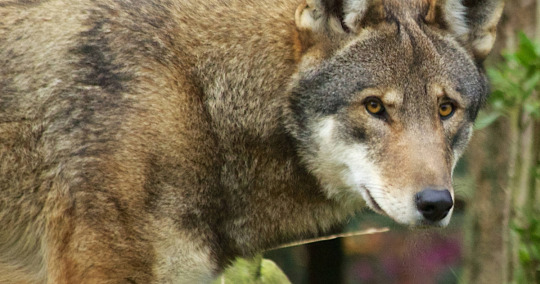
red wolf, canis rufus
the red wolf is a subspecies native to the southeastern united states, intermediate in size between the grey wolf and coyote and sometimes claimed to be a coywolf descendant. they are smaller and narrower than grey wolves and possess longer legs and ears. red wolves are historically habitat generalists, and while their range has been reduced significantly, they can still be found in swamps, forests, wetlands, mountains, and bushlands. they live in familial packs, typically consisting of a mated pair and their offspring, that assist in raising pups. overall, the red wolf is more sociable than the coyote but less social than the grey wolf; they hunt in groups or individually, playful with their pack members but highly antagonistic to strangers. they are omnivorous and generalist feeders, primarily eating deer, raccoons, rabbits, rodents, insects, and berries, as well as livestock. despite being highly endangered, red wolves are apex predators within their biome, though they are shy and secretive around humans. compared to the grey wolf, the most obvious distinction is that red wolf individual is going to be more boundary-keeping and private, willing to engage in conflict in order to maintain their peace. they're highly devoted and loyal to their people, but also value their sense of self and their own identity. they're socially savvy and tactful while also quite adamant. like the grey wolf, they're fairly adaptable and tend to be generalists, but tend to be more sensitive. in addition to the general wolf traits, red wolf daemians are going to be sociable, flexible, protective, cautious, and inventive.

sea wolf, canis lupus crassodon
the sea wolf, also called the vancouver coastal sea wolf, is native to the pacific northwest coast of north america. i included this subspecies because of their fascinatingly unique behavior. like many other wolf subspecies, they live in robust packs — however, they primarily feed on fish rather than hunt cooperatively. they will also forage on other marine wildlife such as seals, otters, barnacles, clams, and whale carcasses. often these wolves will forage alone, incredibly adapted for cracking open mollusks with their teeth. they are strong swimmers; they will migrate between islands on the archipelago, swimming between them and following the salmon migrations. sea wolves are notoriously reserved and rarely seen by people, though they're also powerful predators and have been known to fend off black and grizzly bears. their pack life is highly social and wolves spend most of their time together. when comparing interpretation of this form to the grey wolf, sea wolf individuals are going to be highly specialized and reserved, a unique person who seeks out like-minded companions. they are dedicated companions who are adaptable and inventive problem-solvers; these individuals are the sort who always come out on top, good at finding patterns and adjusting their behavior under challenges. they're socially flexible, both cooperative but possessing a dogged individual ambition. in addition to the general wolf traits, sea wolf daemians are going to be problem solvers, specialized, flexible, sensitive, and supportive.
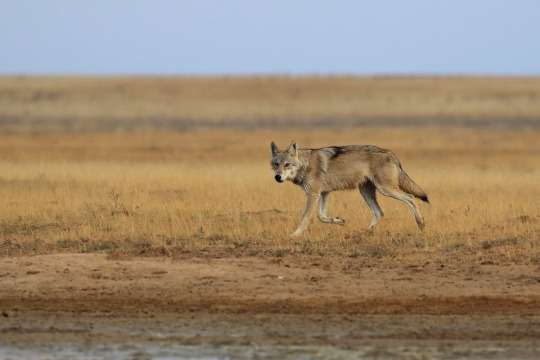
steppe wolf, canis lupus campestris
also called the caspian wolf, the steppe wolf is native to the caspian steppes and neighboring steppe regions. they appear similar to the eurasian wolf, though tend to be smaller on average, have shorter coats, and are characterized by their triangular face. these wolves are voracious hunters; they will hunt cooperatively and alone, preying on antelope, livestock, rabbits, rodents, and even caspian seals. while wolves are notable for taking large game and gorging themselves, steppe wolves have been reported to hunt more than they can consume. they also have an aggressive reputation; they live close to human settlements and pick off livestock, and they also appear to have higher than average rates of intra-pack antagonistic encounters. therefore the steppe wolf individual is going to be someone more bold and cutthroat than the average wolf daeman. they are ambitious and much less conflict-avoidant than other species, including the grey wolf, while still being highly hierarchical. this may indicate that they are sensitive to personal disrespect and disruption that affects group harmony. certainly populations of these wolves are brave enough to attack livestock in broad daylight. confidence is a key aspect of this form, perhaps to the point of arrogance in the name of making sure themselves and those they love are taken care of. steppe wolf daemians, in addition to the general wolf traits, are cunning, bold, adaptable, assertive, and achievement-focused.

tundra wolf, canis lupus albus
the tundra wolf is sometimes mistaken for the arctic wolf. while arctic wolves live in the northern arctic in regions of canada and greenland, the tundra wolf is native to the tundra of northern eurasia from finland to the kamchatka peninsula. they are of medium size and have thick, fluffy coats that are typically light in color. their diet fluctuates with the seasons; typically they hunt large ungulates such as reindeer, elk, bison, and muskox, though in the summer may also take birds and smaller prey. many aspects of this form is going to be similar to the arctic wolf: tundra wolves are going to be resilient, tenacious, and extremely specialized. this subspecies is heavily reliant upon the reindeer population that makes up most of their diet — their southern range is defined by the reindeer's migration. thus while this subspecies is still going to be cooperative, sociable, and tenacious, they're going to be less adaptable and more inclined to plan ahead in order to avoid obstacles. similarly, as they live almost exclusively in the far north or boreal forests, this subspecies is going to be more reserved and unobtrusive particularly compared to the arctic wolf. they have quiet confidence but may come across as aloof to those who aren't in their group of people. in addition to the general wolf traits, tundra wolf daemonians are going to be introverted, perceptive, specialized, tenacious, and conflict-avoidant.
67 notes
·
View notes
Text

This (from Wiki) is a graph of Earth’s temperature over the last 450,000 years. We are, in fact, in the middle of an ice age, the Quaternary Ice Age, defined by the year-round presence of ice at the poles (for now, *cough*). (For Earth’s history as a whole, permanent polar ice is in fact not the norm.)
The Quaternary Ice Age consists in a series of glacial periods, each about 50 to 100 thousand years long, in which glaciers may come down as far south as Paris and New York, separated by brief interglacials, each less than 20 thousand years, in which the polar ice withdraws behind the Polar Circles. That peak in temperature at the right edge of the graph is our own Holocene interglacial, which began 11,700 years ago. The whole of recorded history, everything from the development of agriculture onward, happened inside it, on the trail of a glacial period ten times longer. We could expect it to end, with the onset of another glacial period, some 10 or 20 thousand years from now, but the effects of anthropogenic climate change on this cycle are not yet predictable.
The last interglacial before ours is known as Eemian (in the European nomenclature) or Sangamon (in the American one). It was a very similar period of warming -- in fact, significantly hotter than our own times, with hippopotami wallowing in the Thames -- lasting from 130,000 to 115,000 years ago. Fifteen thousand years of mild weather, well long enough to fit a story as long and complex as the one from the first Levantine wheat farmers to us (and half again).
In that time, Homo sapiens was still a strictly African species, just making short-lived forays into the Near East; Eurasia belonged to our close cousins, Neandertals and Denisovans, and possibly to the last smatterings of Homo erectus in the southeastern jungles. Our dear brothers Neandertals, whose behavior is revealed ever more complex and imaginative, until their sudden disappearence in the middle of the next glacial period.
What were they up to, in the ice-free Europe of the long Eemian greenhouse, long enough for civilizations to rise and fall a dozen times, long enough to go from the stone sickle to the Mars rover? Most traces on the ground would have been erased when the glaciers came down again, the glaciers whose stupendous weight would carve giant lakes from Erie to Ladoga. What if they had already had better places to go to, when our conspecifics showed up in a land that was already depauperated by frost?
Why would anyone think the “little grey people” in UFOs are aliens? Have you any idea how many specific contingent events made up our evolutionary history, how vanishingly unlikely it would be for the human form to arise on another planet? Those are Neandertals, homesick after thirty thousand years of exile, and they’re coming home.
OK, fine, fine, a technological Neandertal civilization would have left massive evidence (intensive farming, driving out of megafauna, fossil fuel depletion, unusual metal concentrations) that we would have noticed, advancing glaciers would not have erased evidence so completely and in fact would not prevent us from seeing isotopic traces of technical activity, such a civilization would not have been confined to Europe and yet there is no trace whatsoever of pre-Homo sapiens human presence in the Americas or Australia, nor there is any trace of sapient activity in the Solar System older than the 20th century, and UFOs are most probably not real. Don’t take this too seriously, guys.
20 notes
·
View notes
Text

I was browsing my bookmarks, and found a good one that I didn't remember... and that turned out to be gone. I ran it through the Wayback Machine, and turns out the site has been down for a few years.
So, for my own sake and for posterity, I am posting it here, because it is useful information.
How to Go Cage Free
Tara Hurlin
I have been researching the care of companion parrots ever since they captured my interest at age 18. Now at age 30, I run a small rescue out of my home that specializes in special needs birds, including parrots with behavioral issues and some with what would consider depression. I take pride and enjoyment out of offering a variety of fresh healthy foods daily, rotating toys a couple times a week, and spending one-on-one time with each of them. Lets put it this way: I never shower alone!
But even after doing all of that, I still felt that I needed to do more. They seemed happy, but something was still off. I visited the Foster Parrots, Ltd. sanctuary in 2013. At first, I thought it was going to be a sad experience; there are around 500 parrots in their care. But when I arrived to see all of the huge free-flight setups, I discovered how happy those birds actually were. It was then that it hit me: I need to find a way to eliminate as many cages as I can.
Even if they are born in captivity, parrots are wild at heart. They are not domesticated animals; their brains are not wired for life in a cage. Depending on the bird, some think of their cage as a safe place to go to sleep and eat, but others act out, get depressed or start feather picking from boredom. The huge, most important part to consider when thinking about going cage free is (pay attention): You must know your bird, and if you have a flock, you absolutely must know your flock.
It took about a year for my rescue, Hurlin’s Parrot Rescue, to convert to going mostly cage free, and we are still changing things weekly. Keep in mind that we have a flock of 20, and it is a slow process because I allowed everyone to adjust at their own pace. In the beginning, I built jungle gyms hanging from the ceiling out of untreated manila rope. I hung a variety of toys, and they used that as a supervised playtime area – supervised so I could learn who may get along with who, or who was going to be a issue with other birds. As an important note: The large birds such as the Macaws are always kept in separate rooms, the Cockatoos in another separate room, and then the Amazons and African Greys in another.
The next step was to add large hanging perches made out of bird safe woods such as poplar, maple, untreated but de-barked pine, and Manzanita wood. It is important to hang all items with either stainless steel chain or plastic chain, depending on your birds (many will chew plastic chain). I installed dishes directly to the stands and hung toys from the chain so they could reach them. Who got to try out their cage free setup first was based upon each individual’s behavior during the supervised playtime trials. For example, I started with the more shy birds that would need more time to establish their territory, let them get situated, then moved on to the Timneh African Greys who had already established their flock. All the while, I routinely weighed each bird to make sure they were maintaining their weight and not losing due to any stress that may be associated with the big changes. My flock personally had no weight concerns during the transition, but better safe than sorry.
[missing image]
When choosing your chain, also make sure that it is safe for little birdie feet. There are certain types known to trap toes.
Meanwhile in the Macaw room, I hung all five of their ceiling play stands in the same day and moved the cages out. Shower curtains were also hung on the walls to assist in their giant poops and food flinging. I did this transition more suddenly because everyone was already used to each other; most had been in the same room for over a year. There is one handicapped Green wing Macaw in this flock, Paco, whose feet were so badly injured that they are paralyzed. Even she is cage-free: I made a play stand that works for her from hula-hoops wrapped in fleece fabric. This works wonderfully, since she is unable to climb or perch, she would just sit in the bottom of a cage all day and crawl through any poop. I had to wash her blankets and bathe her daily. Now she just aims her butt off of the play stand and poops on the papers like everyone else, usually with a little happy dance afterwards!
[missing image]
Even handicapped birds have the potential to live cage free, like Paco the Green Wing Macaw.
During the transition, only a few problems occurred: My Scarlet Macaw, Booboo, who is normally a high-anxiety bundle of nerves and plucks herself accordingly, did pluck her feathers during the first week of the change. Aside from being more nervous than usual, she otherwise seemed happier than normal and in bright spirits, and even began to play with toys – something I never saw her do before. She has now fully adjusted and stopped plucking (until another hormone season comes around, most likely).
There are four birds who unfortunately can never be cage-free, but I found this out in the very beginning during supervised play times. One is our male Eclectus, who puts a lot of effort into chasing down the Amazons, and in turn his friend Velvet also cannot be cage free, because she will find a dark corner and get “nesty”, which is something that we avoid here. The Eclectus species also has different dietary needs. Another caged bird is Toby, our “hot” yellow-nape Amazon, but that was common sense and expected, as he is highly hormonal to the point of unpredictable attacks. And the fourth is Buddy the Red Lory for obvious reasons: he’s a completely different species with different dietary needs, and he is a little guy that could easily get hurt.
About three-to-four months after switching to cage free, there is one bird in particular, Spooky the Timneh African Grey, who began to claim to entire room as his territory and bully the other birds, so as a precaution he maintains a cage while we are not home, but the door is opened at all times when we are home. His setup may or may not go back to cage free again in the future. This is a great example of how flock dynamic can change over time, and you as the caretaker have to be prepared to make any changes that come with it. For me, that was regretfully adding one more cage to the bird room, making five cages total – not bad at all if you consider the flock of 20.
I often get the question of “what if a bird gets adopted, or needs to join the flock?” Similar steps will be taken if another bird is relinquished to our rescue and has the possibility of going cage free. Of course, we maintain our quarantine procedures; our quarantine room is an entirely separate room from any of the other bird rooms. Then, once we are positive the new bird is healthy, he or she is brought into the bird room in a cage to gage reactions from the flock and the newbie. From there, the new bird can move to an open-cage status, then possibly cage free. It is important to note that the majority of birds that are easily adoptable into approved homes will not transition to our cage-free flock. This will avoid stress on them if they find a new family, and it will prevent stress on our own flock. With every bird that comes and goes, the flock is affected and the dynamic changes. We take the time to get to know each bird before making any decisions – as much time as it takes. It is our responsibility to do what is in the individual’s best interest, and for our existing flock.
As for maintaining the cage free setup, new toys, swings, boings and other perches are hung and changed out regularly to keep everyone busy. Most of the birds are flighted and will explore the room, but they always return to their “safe spot” on their own play stands for food, water or sleep (with the exception of a few that prefer sleeping up on the ropes).
[missing image]
It's important to keep your flock busy by adding random foraging areas and rotating toys.
I wish that I could tell everyone that eliminating cages was all sunshine and rainbows – a piece of cake – but it takes a lot of thought and even more work! It may not be for every flock, and I can’t make that decision for you because only you can truly know your birds. Only you know what your setup is capable of and what is realistic for you.
What I can say is that I have no regrets. I have never seen my birds happier. The sparkle in their eyes shines brighter; they chatter more and interact with each other more, even just vocally from across the room. The vibe in the room is much more lively and happy, and I no longer feel the guilt of seeing so many cages lined up around the walls like little jail cells.
A few birds in particular have completely turned around: for example, Ariel, a bird who was locked in a cage for ten years and very difficult to handle due to her mood swings (I self-diagnosed her as being bipolar with possible depression), now constantly asks for me to hold her and accepts preening, almost to the point of cuddling. The first time she did this is a moment I will never forget; it was the kind of moment that reminds a rescuer why they rescue in the first place. Tears of joy filled my eyes. Another change happened in my African Greys, Shelby and Remy. With the cage-free setup they go wherever they please, and that often involves following me wherever I am in the house, which is something I love. They fly back down to their rooms when they decide it is bedtime. Their confidence has become higher from having that independence.
[missing image]
Ariel is a more emotionally stable bird after going cage free.
Another perk for me personally, aside from the happy aura radiating throughout my bird rooms, is that this setup is very low maintenance compared to having cages. I spend less time scrubbing cages bars and bottom grates, which means I can enjoy more time interacting with the flock. What used to take a full day to clean now only takes a couple of hours – and that is a full on OCD bird room scrub down. We have leftover rolls of 48” wide paper donated by our local newspaper distributor. The paper is cut into large sections to completely cover the floors in each room. Smaller sections are laid over the main paper for the extra poopy spots for ease of changing it, and it makes the larger portion last longer. I sweep daily, and I wipe the walls and change papers in their entirety a couple times per week.
[missing image]
Be prepared to sacrifice your wood trim... And doors!
I still continue to make changes to the bird rooms, and this will be an ongoing thing. Another large phase that will take place in spring/early summer 2016 is switching out all of the wood trim for tile or stainless – whichever I find the most cost effective (or the least ugly). Lucky for the flock, I didn’t care for the wood trim we had in those rooms, anyway!
[missing image]
A glimpse of the mostly cage-free setup. Buddy the Red Lory's cage is to the left, and to the right (not pictured) are the other two cages for Velvet and Shifu, and Toby.
[missing image]
Another shot of the same bird room showing the other two cages. An air filter and backup heat (vented to the outside) is also in the photo.
Main Points for going cage free:
Know your birds.
Be patient and observant.
Weigh your birds regularly to make sure they are maintaining weight and health.
Be prepared to make changes as flock dynamics change.
Adjust with the flock; you are part of it.
You better not care about your trim or possible furniture in the room, or have plans to change to un-munchable trim, like tile.
Keep them busy by changing out perches, toys and foraging activities. It’s like having a caged setup, but on a larger scale with no bars, so you have to get creative.
Enjoy watching your flock be a flock, and take pride in being part of it.
3 notes
·
View notes
Text
HUMAN DESIGN BASICS USING JOVIAN ARCHIVE
You can read all of this, but to understand Human Design better you should start by knowing your strategy and authority. Then practice them on every single thing no matter how minute.
Human Design answers the question, How can I not struggle? It is based on calculations similar to astrology by using your birth time, birthday, and birth location. Human Design is a system that brings together principles of The I Ching, astrology, Kabbalah, Hindu-Brahmin chakra system, and quantum physics. Human Design is about listening to your body and not your mind.
As a psychologist, I would say Human Design also incorporates behavioral psychology to help users achieve a state of 'congruence' with their bodygraph.
Human Design is represented by a bodygraph- an illustration of the body with lines which may be red, black, half of both, a combination of both or white, 9 centres (5 triangles and 4 squares but one of the squares looks like a diamond) and numbers. These squares and triangles may be grey/white or coloured(filled in). When they are coloured, they are known as defined centres; when not filled in, they are known as undefined centers. The following image(s) is a bodygraph and everything else mentioned in this post.


Type:
There are five types. Manifestors, Generators, Manifesting Generators, Projectors and Reflectors. In Astrology there are rising signs while in Human Design there are Types.
Strategy:
This is how we use our energy. Here is a table of types against their strategy.

Authority:
This is how to make decisions that are individually correct. There are seven authorities:
Solar Plexus (Emotional Authority)
Sacral (Sacral Authority)
Spleen (Splenic Authority)
Heart (Ego Authority)
G (Self Authority)
Environment (No Inner Authority)
Moon (Lunar Cycle)
Definition:
This is about the definition of centres. Defined centres are areas of your chart that you are not easily influenced in decision-making. Undefined centres are areas where you are bound to be easily influenced by others(groupthink). There are five definitions.
No definition
Single definition
Split definition
Triple split definition
Quadruple split definition
Profile:
These are the numbers that differentiate you from other energy types. For instance being two projectors but different profiles make you very different from each other. The profiles are made from a combination of six lines(numbers). Each Line has two profiles.
There are 12 profiles:
1/3 Profile
1/4 Profile
2/4 Profile
2/5 Profile
3/5 Profile
3/6 Profile
4/6 Profile
4/1 Profile
5/1 Profile
5/2 Profile
6/2 Profile
6/3 Profile
Each line represents something.
Not-self theme:
This is an indicator that you are not being yourself.

The opposite of not self theme even though not listed in the above charts, is self theme.

CHANNELS,GATES AND COLORS
The lines in the bodygraph are known as channels. The numbers are known as gates.
Since I am African my explanation is going to be African. A channel is like a road, a gate is like a starting point and ending point. Here is an example:
The Trans African Highway(see this as a channel) starts at Cairo(see this as a gate) and ends in Egypt(see this as a gate). When Two gates are connected, they form a channel. If the Trans African Highway did not have a starting and ending point, it would not be in use as it would be an arrested development. In Human Design we call this an activated channel because it will be filled in and not white. However, sometimes only half of it is filled in.
The red in your chart is on the left side of the bodygraph and it represents your subconscious. The black is on your right and it represents your conscious mind or personality. So this is what the colours mean when the lines in your bodygraph are coloured in. When you see both colors together it means both your subconscious and conscious share those traits.
There are 64 gates(the numbers) and 36 channels(the lines).
Arrows in the bodygraph:
There are four arrows. Two on the right and two on the left. On the right(personality side), the top arrow means awareness. When the top right arrow faces left it means strategy and logic while when it faces right it means imagination.
The bottom right arrow means manifestation and perspective. When it faces left it represents clear and concise-specific- while when it faces right it means unspecific.
The top left arrow represents digestion while the bottom left arrow represents the environment.
When the top left arrow is facing left it means active digestion while when it's facing right it means passive digestion. When the bottom left arrow is facing left it means consistency and structure while when it's facing right it means diversity.
Incarnation cross:
There are THREE types.
1. Right Angle Incarnation cross (RAC)
2. Juxtaposition Cross (JC)
3. Left Angle Cross(LAC)
So below I ONLY mention the RAC
This is not fated but it's a pattern you may find yourself leaning towards. From MY PERSONAL observations, when you draw lines to connect the numbers(these are gates) in the incarnation cross, they form a right-angled triangle. There are 192 incarnation crosses.
Below are the two charts from above after I have joined the lines to the gates in the incarnation crosses. The dotted lines in the diagrams below are to complete the right-angled side.
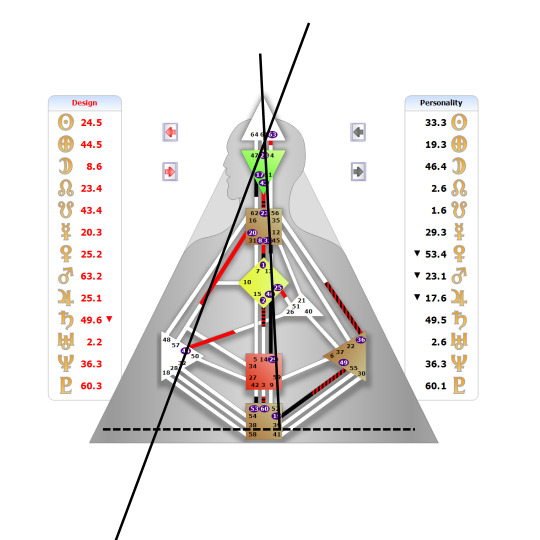
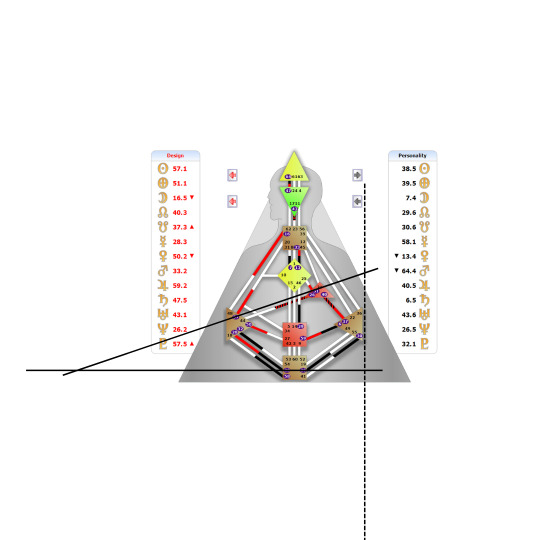
Planets
On the right and left sides of the body chart are planets in this order:.Sun, Earth, Moon, North Node, South Node, Mercury, Venus, Mars, Jupiter, Saturn, Uranus, Neptune and Pluto.
Right next to the planets are numbers with a decimal. The single number before the decimal is a line and the right side is a gate. In Astrology, there are planets in houses while in Human Design there are Planets in Gates.
You can find me on Instagram here:
#human design#behavioral psychology#astrology#Jovian Archive#Manifesting generators#Projectors#strategy and authority
95 notes
·
View notes
Text
Protect your feathered friend from silent killers in your home! Learn how to safeguard your bird from toxic fumes and create a safe haven. Read now and breathe easy!
#african grey#african grey lifespan#tiktokparrot#african grey parrot lifespan in captivity#buying an african grey parrot#african grey behavior#african grey parrot care#cute birds#african grey parrot#africangrey#african grey life#african grey parrot website#african grey website#avian health#avian respiratory system#avian wellness#bird behavior#bird care#bird care at home#bird care tips#bird conservation#bird environment#bird feeder safety#bird habitat#bird habitat preservation#bird health#bird health tips#bird lovers#bird owners#bird parenting
0 notes
Text
Who is the Most Talkative Bird

Parrots are known for their remarkable ability to mimic human speech, but one species stands out as the most talkative: the African Grey. This article delves into the fascinating world of the African Grey parrot, exploring its features, characteristics, and the reasons behind its reputation as the most talkative bird.
Who is the Most Talkative Bird?
The title of the most talkative bird is held by the African Grey parrot. Native to the dense forests of central and western Africa, these birds have gained immense popularity worldwide due to their exceptional vocal abilities and intelligence.
Two main subspecies are recognized: the Congo African Grey and the Timneh African Grey, both of which are noted for their speech and sound mimicry.
Features and Characteristics
Here are some features and characteristics of african grey parrot.
Physical Description
African Greys are medium-sized parrots with a predominantly grey plumage. The Congo African Grey typically has a bright red tail, while the Timneh variety sports a darker, maroon tail. They have a strong, curved black beak and are roughly 12 to 14 inches in length.
Cognitive Abilities
These parrots are not just talkative; they are also incredibly smart. African Greys have shown cognitive abilities comparable to those of young children in certain aspects. They can solve puzzles, understand concepts like bigger/smaller, and even grasp some aspects of causality and time.
Vocal Abilities
African Greys are known for their wide range of vocalizations, including whistles, squawks, and most impressively, human speech. They can learn an extensive vocabulary, often using words contextually correct. Some African Greys have been known to learn hundreds of words and sounds, showcasing their unparalleled mimicry skills.
Social Behavior
In the wild, these parrots are social creatures, living in flocks. They form strong bonds with their mates and are known to be quite affectionate and playful. In captivity, they require a lot of social interaction and mental stimulation to stay happy and healthy.
Do I Need to Train African Grey Bird to Talk?
Training an African Grey parrot to talk is often a rewarding process, both for the bird and its owner. While these parrots are naturally inclined to mimic sounds and speech, effective training can significantly enhance their ability to talk and use words appropriately. Here are some key points to consider when training an African Grey to talk:
Start Early
The best time to start training is when the bird is young. Young parrots are more receptive to learning new sounds and words.
Regular Interaction
Frequent and consistent interaction is crucial. Talk to your parrot regularly, as they learn by listening and then mimicking the sounds they hear.

Clear and Repetitive Speech
When teaching new words, speak clearly and repetitively. Parrots learn through repetition, so consistently using the same words or phrases will help them pick up on these quicker.
Positive Reinforcement
Use positive reinforcement techniques. Reward your parrot with treats, praise, or affection when it successfully mimics words or sounds. This reinforcement encourages them to repeat the behavior.
Create a Conducive Environment
Ensure your parrot's environment is conducive to learning. A stress-free environment with minimal distractions aids in better concentration and learning for the bird.
Social Interaction
These birds are social creatures, and they learn faster in an interactive environment. Regular social interaction can stimulate their learning process.
Patience and Consistency
Be patient and consistent in your training. Some birds may take longer to start talking, and their ability to learn words varies.
Variety of Words and Sounds
Expose your parrot to a variety of words and sounds. This can include everyday conversations, music, and even watching television with them.
Remember, while most African Grey parrots have the capacity to develop impressive verbal abilities, each bird is unique. Some may naturally be more inclined to talk than others. The key is to create a nurturing and stimulating environment that encourages them to use and develop their vocal skills.
Why It Is Considered the Best Talkative Bird?
Here are some reasons:
Clarity of Speech
The African Grey's ability to mimic human speech is not just about the number of words they can learn; it's also about the clarity with which they speak. They can replicate the tone and pitch of human voice remarkably well, making them sound almost like a human speaker.
Contextual Understanding
Unlike many other parrots that mimic speech, African Greys often show an understanding of the context in which words are used. This ability to use words appropriately in context sets them apart from other talking birds.
Emotional Connection
These parrots are highly sensitive to their owner's emotions and can sometimes use their vocal abilities to respond to these emotions. This emotional connection they establish with humans is a significant factor in their ability to communicate effectively.
Longevity and Learning
African Greys have a long lifespan, often living up to 50 years or more in captivity. This longevity gives them ample time to learn and refine their language skills, making them more proficient speakers as they age.
Conclusion
The African Grey parrot's combination of clear speech, contextual understanding, emotional intelligence, and a long lifespan make it the most talkative and arguably the most intelligent of the parrot species. Their remarkable abilities extend beyond mere mimicry, reflecting a deeper cognitive prowess that continues to fascinate and delight bird enthusiasts and pet owners worldwide.
FAQs
What bird is the best at talking?
The African Grey parrot is widely considered the best at talking. Known for their ability to mimic human speech with remarkable clarity and intelligence, they excel in both vocabulary and understanding.
What is the best talking bird to own?
The best talking bird to own largely depends on the owner's lifestyle and experience with birds. African Greys are excellent for their talking ability, but they require significant social interaction and mental stimulation. Budgerigars (budgies) are a good choice for beginners, being smaller, easier to care for, and also capable of learning a variety of words.
Which bird is considered the best talker?
The African Grey parrot is generally considered the best talker. They are not only adept at mimicking human speech but often understand and use words contextually, showing a high level of cognitive ability.
Which is the intelligent talkative bird?
African Grey are not only talkative but also highly intelligent. They can understand and use language contextually, solve complex problems, and are known to have a level of intelligence comparable to that of a young child.
What is the 2 loudest bird in the world?
The two loudest birds in the world are the White Bellbird, which holds the record for the loudest call of any bird, and the Kakapo, a type of parrot known for its very loud, booming mating calls. These birds are renowned for their volume rather than their ability to mimic speech.
Read the full article
3 notes
·
View notes
Note
Hi, i’ve been looking at your post, talking about it, and sharing it with some friends. Honestly i’d even say i’m a fan of you and your work despite how little of it there is right now. I have a couple question.
First, I was wondering if you had any other accounts that I could follow your work on, like twitter and such.
Second, I saw that you took classes in etholgy and talked about advocating for the personhood of animals. I mean, I know they’re smarter than we sometimes give them credit for. Take for example the recent study with scientist communicating with whales with their own language for the first time. But I was hoping to get your insight in what you mean by personhood of animals and thoughts on the topic. (And also table napkin thought on how anthropomorphizing can harm or help our understanding of animals)
Third but a little more obscure, is that you use humanity, personhood, and the being of « more human » a lot. I was hoping if you could expand on the differences of these terms and how they interact with one another.
Sorry for all the questions, just honest to god fascinated with your perspective of things and the topic in general.
Here’s the whale communication study I mentioned: https://globalnews.ca/news/10182116/humpback-whale-conversation-talking-to-aliens/amp/
Oh my gosh thank you so much for your kind words! This, AO3, and YouTube are actually my only accounts online that I post anything on, and I just use my YT account to reupload other people's deleted videos. I used to use Reddit but I'm trying to distance myself from that account since half a decade of hot take type comments starting when I was 15 isn't exactly the best look for anyone.
Your last two questions are linked so I'm going to address them at once. Human is simply the term used to refer to a member of the genus Homo. There's nothing all that special about it philosophically when separated from personhood, which is more or less the description of what beings do and don't fully matter morally. Speculative fiction and philosophy tend to equate it with sapience, which is more or less a meaningless term made up to separate humans (or worse, specific groups of humans) from other animals and make ourselves feel superior. There have been attempts to give it meaning, but nearly every definition uses traits that are found in at least one other species of animal and/or are not universal to every group of humans (with the notable exception of artistry but I frankly find it absurd to discount something's moral worth over that). As such, if we're going to approach the topic logically, then some animals at the very least have traits of personhood.
Language, for example, isn't exactly common in animals, but it isn't unheard of either. Bats, cetaceans (whales and dolphins), pinnipeds (seals and sea lions), elephants, songbirds (a group that contains crows btw), hummingbirds, and of course parrots all learn different "words" that they apply meaning to and then use. Cetaceans, parrots, and some songbirds even use something akin to grammar.
Ritual behavior has been shown in chimpanzees, dolphins, and elephants as they grieve for their dead.
Self-awareness, the trait most commonly held up as making humans special, is hard to measure due to the language barrier, but there is still some evidence for it in certain animals. The mirror test isn't perfect when it comes to discounting a given animal's self-awareness, but if an animal can identify itself in a mirror, it's hard to argue with the idea that it has a sense of self. Animals that passed include various dolphins, great apes, elephants, magpies, and even certain fish. Furthermore, an African grey parrot named Alex once asked a question about himself, being the first recorded instance of an animal asking anything, and bottlenose dolphins use names for themselves and others in their pod.
I could go on and on, but I think you get the point. I don't really have a definitive list of animals that I believe should be considered "people", especially given all the legal implications of that sentiment, but you've probably noticed that same groups of animals showed up again and again. Dolphins were there in all of the different categories, and elephants only failed the grammar category because they largely communicate using vibrations which work so differently from regular sound that they're hard to meaningfully compare to human languages. Parrots, corvids (crows and relatives), and great apes all have stand out members that showed up in two or three of the categories in the African grey, magpie, and chimpanzee respectively, and the other members of those families as well as whales are all intelligent and social enough that I am of the opinion that they all deserve certain philosophical rights and even legal protections. It's so easy for us to see personhood as a black and white thing that something either has or doesn't have, but like most things, it really is more of a spectrum.
To answer your "table napkin thought", while I won't deny that anthropomorphizing real animals can often lead to a lack of true understanding of them, the harm done by people trying to avoid doing so is both more common and so, so much more horrific that I hesitate to critique it too much. I mean, I have straight up seen very influential people say that acknowledging the extremely well supported fact that other animals are capable of feeling pain is "anthropomorphizing" them because one specific area of the brain that is partially responsible for processing pain in humans is only present in primates, and that of course can, and historically has, lead to horrific abuse.
I really don't mind all the questions! I love talking about things I'm passionate about, and this topic is certainly up there among the the things I care most about.
3 notes
·
View notes
Text
A small tip of perspective for those that struggle to navigate their own needs but are animal lovers / pet parents, try to approach yourself and your needs (and for systems, parts and system needs) as if you were trying to understand a specific needs profile of a breed / version of the pet aren't the most aware of and don't have the ability to look up. I don't know how well this applies to non-dog/bird species, but largely in birds and dogs, there is a large variety of needs depending on the species / breed you get and even within species and breeds. What one needs is going to be drastically different from the other
What sort of enrichment is necessary to make this animal happy and able to live to the most of their natural behavioral capabilities? What sort of social exposure and activity does this animal need to meet their needs and make sure they have an enriched life? What have they been eating? Has it been one same meal over and over again beyond the point of enjoying it still? When was the last time things were changed up? When was the last time they were bathed or given the opportunity to see something new?
Largely our system is a bird, and like any bird, you really can't keep them in a cage all day so we have system rules that we should try to leave the house every day for at least an hour and preferably go somewhere that has something to look at that we haven't done in a while. We call this the "Fly the Coop" time and its just a general welfare rule. Treat the bird in our brain like the bird it is and give it it's "outside time" because not giving a bird that would be very bad for them.
We also are a parrot to be specific so it is very important to give us something to work on, a puzzle to figure out, and active mental stimuli and enrichment. We have a very high curious and drive to learn and figure things out, so like any particularly curious parrot, its important to lay out a number of activities, problems, and puzzles for us to figure out and build on - as a result it is important for us to always have a list of skills and problem solving and creation related things availible for us to engage with.
We are also very social but we aren't so much the active cuddler (save for specific parts) and active affectionate type, so much as we are more around the ways of an African Grey or Cockatiel that needs passive company and benefits from a mutually engaged environment; so it is important to have people (or birds for our case as it fills the need) around us doing their own thing and even better if they are also engaged as it lets us relax in an engaged state. Mutual engagement is one of the solid bonding activities. Additionally, we fill our social needs often in the form of social bathing, social eating, and general social cleaning / preening, so when possible, its good to put ourselves in environments where others are doing similar and/or bring our close people and our birds into those activities with us.
Routine is highly important to us as well which again is a good parallel to parrots so we keep that in mind.
With the general frame work, we can really easily apply a mental check list / needs list by largely applying a "welfare and needs" marker for a "non-existant parrot" and apply that to ourselves so rather than trying to figure out what "We Need", we can just make sure we have made sure the parrot need profile in our head has been met.
Largely following the general caresheet for the specific type of parrot that we are has honestly led to a lot better self care and day to day management of our mental, psychological, and physical health so its a perspective thing I do recommend.
11 notes
·
View notes
Note
Hi, I was wondering, what do birds do around your home and how do they interact with you? I feel like we know so much about other animals as pets but not birds.
This is a great question! I really wish more information about birds existed in the cultural ether, especially because so many birds are surrendered to rescues by people who didn't know what to expect. I am going to talk more generally about birds as pets, (long answer incoming), with specifics about my own birds at the end:
Birds are a very diverse group of pets. Unlike dogs and cats, pet birds comprise many different species (not breeds) that exhibit their own behaviors and personalities. This includes everything from pigeons to macaws to songbirds, originating from different regions all around the world. Alongside owning and fostering multiple bird species, I also write bios for my local rescue and create educational materials, so I know a lot about the daily challenges and joys of owning birds as companion animals. While it's true that no two dogs or cats are the same, it's even truer that no two birds are alike.
Based on my volunteer work and personal experience, here are the primary factors that influence daily life with a bird: species, tameness, flightedness, personality.
More info under the cut for those interested -- plus information about my life with personal and foster birds!
SPECIES: Some species, like finches, aren't super interactive or hands-on with humans. Other species are highly social and can become tightly bonded with owners. Cockatiels often bond with one person, for instance, and can be quite clingy. Some species, like Quakers, can be very territorial around their cage but are often friendly and goofy outside the cage. All species have their own unique vocalizations and body language. Birds like cockatoos and African Greys are talented talkers and can have a rich vocabulary. Other species (and female birds) are less likely to talk. Behavior, diet, and cage requirements vary drastically between species.
TAMENESS: This refers to how comfortable a bird is with human handling. Many birds we get at my rescue are not hand-tame, meaning they won't step up onto an outstretched hand and might even bite if threatened. We do rehabilitative fostering, which means we teach birds to trust human contact and companionship. Hand tame birds will step up and hang out with their owners. Some (but not all) will even request head scratches --though this also depends on personality. Trusting, trained, and hand-tamed birds can be taught tricks. Birds are very discerning animals, and they are picky about who they choose to trust. They are more likely to trust people who respect their boundaries and read their nonverbal cues.
FLIGHTEDNESS: This refers to whether a bird is a capable or active flyer. Not all birds are skilled at flying, or even want to fly. Some owners will clip feathers to prevent birds from flying, usually for safety reasons (though this is controversial practice among certain circles.) Flighted birds have more autonomy when outside the cage, exploring, stretching their wings, and perching in high up places. Even fully flighted birds in a bird-proofed home still need a cage to sleep in and feel secure.
PERSONALITY: Some birds are clowns, others are sassy. You get meek, brave, prissy, adventurous, gregarious, docile, reserved, etc... Bird personalities are every bit as complicated and diverse as human personalities. Some birds enjoy scratches and show affection by snuggling against their owner's neck, chin, or hands. Other birds don't want to be touched and will bite or hiss if provoked. Likewise, some will want to spend every waking moment with their owner, while others will be more independent. Birds are highly intelligent. They can learn to understand words, hand gestures, and environmental cues. As flock animals, they also have social and emotional intelligence.
Now that I've gotten the general facts out of the way, here are some details about my own feathered friends:
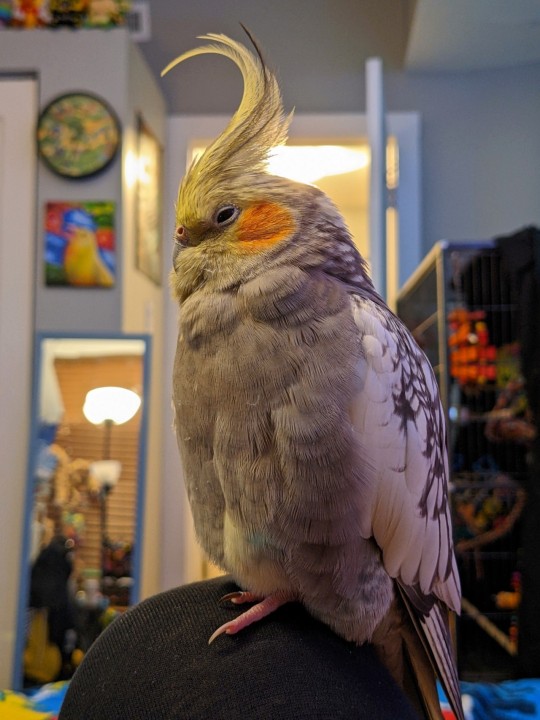
Pixel the cockatiel: She's the main bird on this blog, because she's also my most interactive companion. Pixel is a fully hand tame cockatiel, meaning she will step up onto my hand and hang out on my shoulder. She has a big flight cage full of colorful toys with confetti shredders and woodblocks for stimulation, plus rope boings, noisemakers, and popsicle sticks (she's spoiled). I buy her new toys often and cycle them so she won't get bored. I cover her cage at night to regulate her hormonal cycles and prevent egg laying (birds need about 10 hours of darkness every night.) I uncover her in the mornings and feed her breakfast (a mix of nutriberries and Zupreem pellets, supplemented with fresh veggies for lunch and dinner). Once she is finished, she will often fly to my head or shoulder and hang out with me while I work at my desk. She loves distracting me by chewing on my earrings, grabbing my pencils, and walking on my keyboard. Lately I've been letting her play with my grandmother's button collection. She will toss them around and make a mess! She also looooves head scratches and will gently peck my hand and bow her head to request more. She gets frustrated when I'm too preoccupied to give her attention. She takes naps in the late morning, sometimes on my lap or shoulder, and occasionally on the back of my desk chair.
On slower days, we have training sessions. I've taught her how to spread her wings, spin around, and wave her foot/make a little fist. Since Pixel is fully flighted, we also do flight training to ensure she remains healthy and coordinated. She will fly to my shoulder or hand from across the room. This kind of training is important in case Pixel somehow escapes outside, so she will know to fly back to me. I also plan on microchipping her soon.
Because birds are prey animals, they can get spooked easily. When Pixel is scared she will take off and fly around my house (this probably happens once a day, or a few times a week minimum). While she's a skilled flyer, this can be dangerous around mirrors and windows. She has several spots throughout the house where she knows to land, but it's important not to make sudden threatening movements or loud noises around birds to prevent them from getting spooked or losing trust.
When I'm away, I put on music for Pixel so she won't feel lonely -- usually a mixture of piano and birdsong, but sometimes aviary videos. When I get back home, she contact calls (AKA “screams”) because she wants to be with me. Contact calls are vocalizations that cockatiels make to locate flock members (AKA me). I let her out of her cage and she will ride around on my shoulder while I do chores or prepare food. We eat dinner together. She has a little stand with food dishes that I keep next to the table. I put her to bed around 7:30-8:00. When I climb into bed a few hours later, I will say “good night!” and she will answer with the softest, sweetest little “bweeep?” It melts my heart every time. Weekly, I will clean her cage and give her a spray bath, and every 3 or 4 months I take her to the vet for a nail trim.
She's quiet compared to some bird species, but she does squawk if I leave the room when she wants to be near me. I've also been socializing her with other people. When I first got her as a foster, she was terrified of my dad, the maintenance man, friends. But now she will perform tricks for my friends and family, and even step up on their shoulders if coaxed with treats. I've also traveled with her multiple times, both to the vet and on longer road trips. She's pretty adaptable and becoming better every day. She will climb into a bird backpack, and I have a smaller travel cage for her.
I had a childhood cockatiel named Kiiro, and I've been a bird-sitter for tiels at the rescue. They all have their own personalities and opinions. Some are more social with other birds, and some prefer human company. Pixel was my first foster bird and now she's an amazing family member. I'm so grateful that fate brought us together.
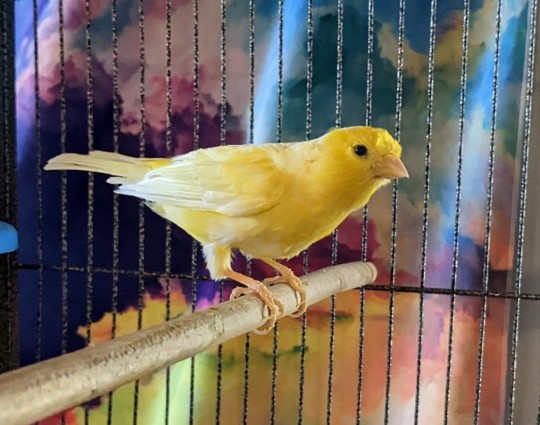
Jitterbug the canary: Jitterbug is the love of my life, and the first pet bird I got as an adult. I've had him for about 4 years now. He's a tiny, happy boy -- not hand tame. I don't let him out to fly, since he gets spooked easily and he's a clumsy flyer, but he lives in a HUGE bird mansion (even bigger than Pixel's cage) which I position next to a window. Male canaries are great singers. I usually don't cover him at night, so I wake up when he starts singing around 7:30/8:00am. His songs sound like laser beams. In the mornings I get him fresh food and water. I also clip spinach to the side of his cage which he eats with gusto. He takes little birdbaths throughout the day, splashing in his water dish. He likes watching videos, especially live birdfeeder webcams (I call them his "soap operas"). I put him to bed at sunset. He's super low maintenance and enjoys compliments.
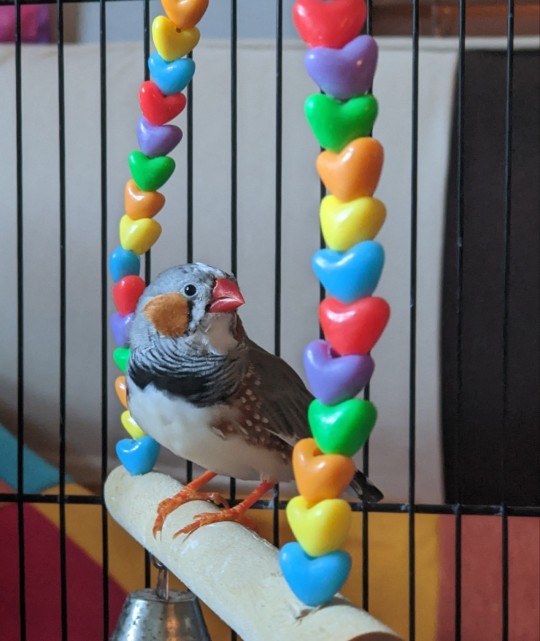
Mr. Kazoo the zebra finch: My foster Mr. Kazoo is an elderly zebra finch, now partially hand tame. My routine with him is similar to Jitterbug, except I also give him a vitamin supplement in his water. He will hop onto my hand for millet, and he's vocally responsive to humans. If it were up to him, we would beep back-and-forth all day. He also builds tiny nests in a coconut hanging toy, using little sprigs of confetti and paper. The cutest little dude.
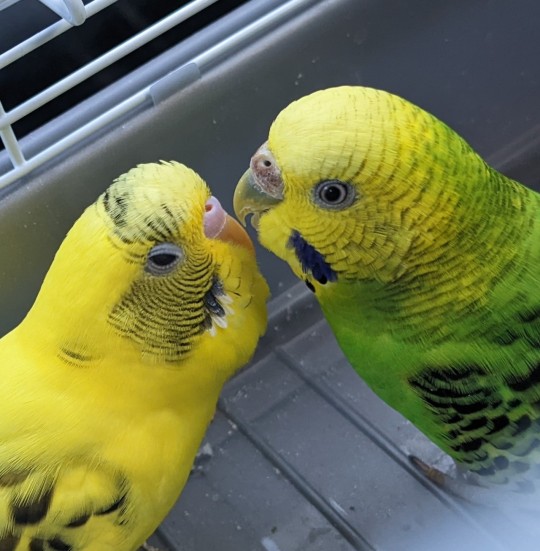
Parakeets (Bob and Helen): Throughout the spring and early summer, I fostered a pair of parakeets who had been found outdoors in a birdhouse. Most likely they had been released or abandoned by previous owners. These two were not hand tame, (they would bite when I tried to interact), but they were fully flighted and would zip together around my apartment. I gave them time to exercise outside of their cage a few times a week. They were a cute, chatty little couple. Much messier than any of my other birds though.
General notes on living with birds: It's easy to romanticize life with birds (it's really great), but I also want to note some of the quirks and inconveniences.
Molting is crazy. Be prepared to have feathers everywhere once or twice a year (depending on the species).
Seeds will be all over your floor. (I hope you like vacuuming).
Keep tissues or toilet paper handy for the poop. Most species will poop about every 20-30 minutes.
Birds can be loud. I have auditory sensitivity, but I've gotten used to them.
Avian vets are sometimes hard to find and expensive. Birds also hide illness, so you have to be attentive to catch health issues early.
Birds can live a looong time. Some species can live as long as us. Make sure you are financially and emotionally ready for the commitment.
Not all birds enjoy human company, and they do things on their own terms.
Birds like getting into trouble, chewing on things, stealing shiny objects, breaking necklaces, etc. Pixel once threw 3 consecutive pieces of jewelry into the sink drain while I was preparing for a formal event. Due to their intelligence, they will misbehave if they aren't getting enough attention or stimulation.
I know this was a long response, but I hope it was entertaining and clarifying! I wish information about daily life with birds were more readily available. It's a joy coexisting with them :)
14 notes
·
View notes
Text
⛰️my introduction🐺

now playing: p.h.f - i hate myself
hello im dire or rosie. call me whatever.
17 yo self shipper and oc x canon artist. i sometimes draw. i am obito’s, danzo’s and sukuna’s spouse /srs.
furry and brony. im also a dire wolf and african grey parrot therian, elfkin, and dragon otherkin.
im an irl aka fictionkin of pain/nagato (source: naruto), kenny mccormick (source: south park), and nero (source: dmc 4 and 5). i dont ship my irls/fictionkins with my f/os whatsoever.
am black-american, latino, and indigenous. i have autism, adhd, and ocd. i have borderline behavior too. i will say slurs i can reclaim here.
im an xenogender with unlabeled gender, who’s also aroace spec (grey aromantic and grey aegosexual), demiromantic, fictosexual, bisexual and ambiamorous. im an inclus and left leaning individual so expect some political reposts here and there from time to time.
i might sometimes write. though, my writing may stink, since i dont read a lot, nor practiced a lot with my writing yet. and i mainly do roleplay (including with ais. which rping is also kind of a way for me to practice my writing too). i will do random writing requests but i dont do y/n x canon stuff
i dont have a dni but with all due respect. please dont follow me or interact with my posts if you’re problematic, pedo/zoo/necro or supports incest, a nsfw acc, interact with nsfw posts, and/or write nsfw. this also include not respecting my identity. thanks :)
✨i will block whoever and whenever i want freely.✨ if i block you on this site then it’s probably because you broke boundaries, i just dont like you, or dont feel comfortable with your content and the things you post
asks and requests: closed for now
commissions, art trades, etc: closed

⚠️WARNING⚠️: my content may contain sensitive or suggestive content (not borderline porn tho). pls be wary of that before you even interact with my stuff!!! if you skip this part and got offended by the stuff i posted, that’s on you and your problem, not mines!!! dont say i didnt warn ya. because i did ;P
im gonna treat this place like twitter now lol
#furries#furry#furry art#furry fandom#intro post#introduction#self ship#self insert#fiction#fictosexual#shipping#fanfic#therian#otherkin#elfkin
2 notes
·
View notes